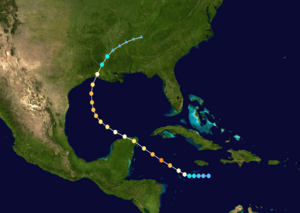Hurricane Delta facts for kids
Hurricane Delta was a strong hurricane that happened in October 2020. It hit the Yucatán Peninsula in Mexico first. Later, it moved towards the United States, threatening parts of Louisiana, Mississippi, and Alabama. Many people in coastal areas had to leave their homes for safety. At its strongest, Delta's winds reached about 145 miles per hour (233 km/h).
The storm also worried people on islands in the western Caribbean, like the Cayman Islands, Cuba, and Jamaica. Warnings were put out for Mexico, the Cayman Islands, and Cuba to help people prepare.
Hurricane Delta was the fourth named storm in 2020 to hit Louisiana, which tied a record. It was also the tenth named storm to hit the United States that year, setting a new record.
In Mexico, the hurricane knocked down trees and power lines. It also ripped roofs off houses and other buildings. When Delta reached Louisiana and Southeast Texas, it brought heavy rain, strong winds, and a storm surge (a rise in sea level caused by the storm). There were also 14 weak tornadoes confirmed in Mississippi, Alabama, Georgia, and the Carolinas. The total cost of damage covered by insurance was about $3.09 billion. Most of this was in the U.S. ($2.9 billion), with $186 million in Mexico.
Contents
How Hurricane Delta Formed and Moved
On October 1, 2020, experts started watching a weather system called a tropical wave in the Caribbean Sea. It was moving west and slowly getting more organized.
By October 8, Delta became much stronger. It reached Category 3 hurricane strength again. A few hours later, it hit its second strongest point. Delta stayed this strong for six hours as it turned north.
As it moved, Delta entered an area with cooler water, drier air, and stronger winds higher up. These conditions made the hurricane start to weaken slowly. It became a Category 2 hurricane as it moved towards land. Delta then made landfall near Creole, Louisiana, with winds of 100 mph (155 km/h).
After hitting land, Delta weakened even faster. It became a Category 1 hurricane an hour later and then a tropical storm six hours after that. The storm sped up and moved northeast, changing into a different type of weather system over Western Mississippi. It continued to weaken and spread out, eventually becoming just a low-pressure area over the southeastern U.S. by October 12.
What Happened After the Storm
Mexico's Recovery
In Cancun, electricity and water services were back to normal within a week after Delta passed. Groups like the Convoy of Hope gave out supplies to families who were affected by the hurricane.
United States' Recovery
Louisiana's Efforts
Right after Hurricane Delta, Louisiana's Governor, John Bel Edwards, said that many thousands of people would need help to recover from the storm's damage. He also visited the areas that were hit hardest to see the damage himself.
Hurricane Delta's Records
Hurricane Delta set some new records and tied others:
- It was the earliest 25th tropical or subtropical storm ever recorded in an Atlantic hurricane season. It broke the old record set by Tropical Storm Gamma in 2005.
- Delta quickly grew from a tropical depression (with winds of 35 mph or 55 km/h) to a powerful Category 4 hurricane (with winds of 130 mph or 215 km/h) in just 24 hours. This was the fastest such growth ever seen in the Atlantic Ocean.
- Delta was the tenth named storm to hit the continental U.S. in 2020, which was a new record. The old record was nine storms in 1916.
- It was also the fourth named storm to hit Louisiana in 2020, tying a record set in 2002. Later that month, Hurricane Zeta broke this record.
Images for kids
-
An enhanced satellite image of Delta making landfall in Quintana Roo on October 7.
-
A radar image of Delta making landfall in Louisiana on October 9.
See also
 In Spanish: Huracán Delta para niños
In Spanish: Huracán Delta para niños







